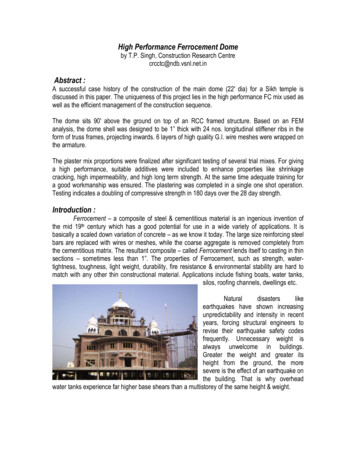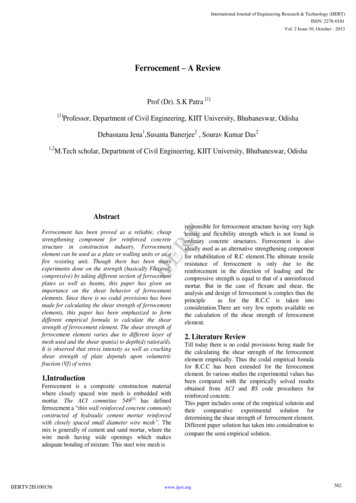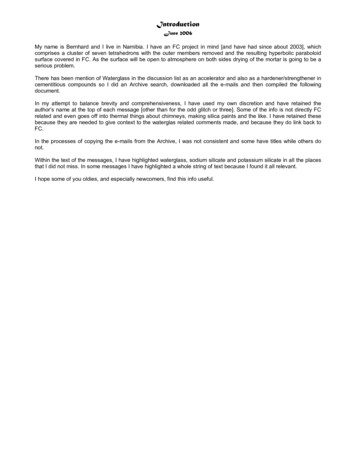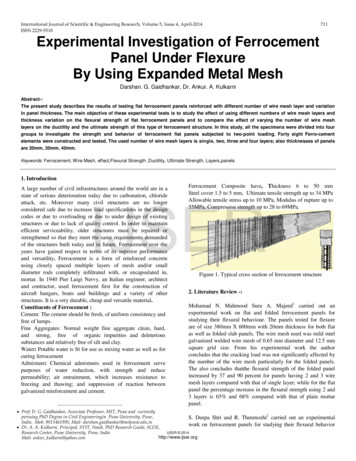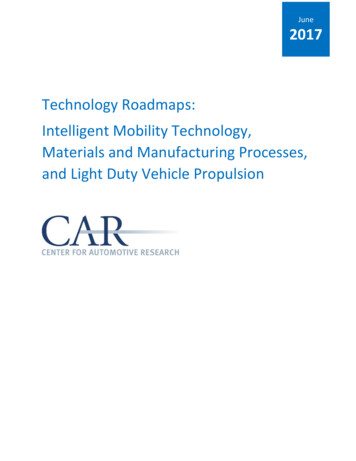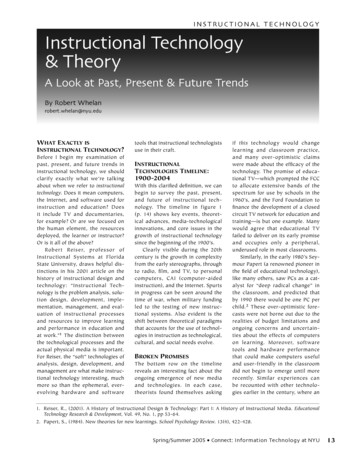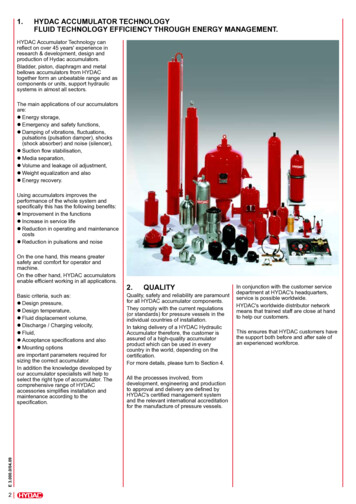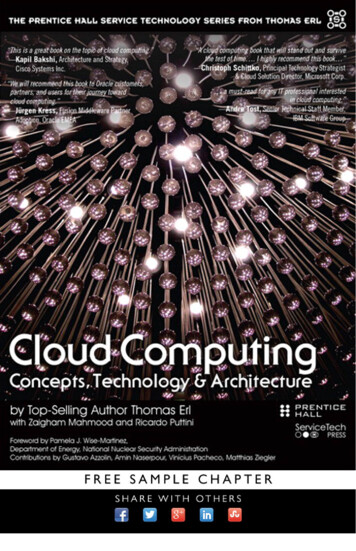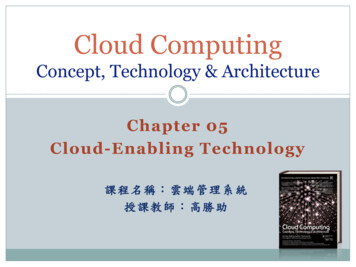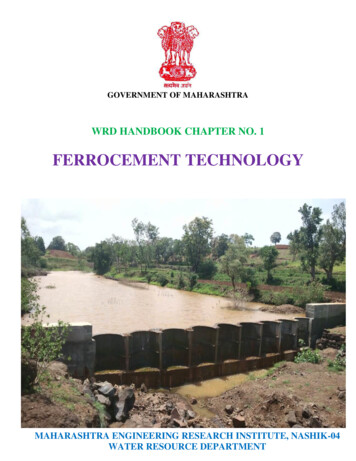
Transcription
GOVERNMENT OF MAHARASHTRAWRD HANDBOOK CHAPTER NO. 1FERROCEMENT TECHNOLOGYMAHARASHTRA ENGINEERING RESEARCH INSTITUTE, NASHIK-04WATER RESOURCE DEPARTMENT
GOVERNMENT OF MAHARASHTRAWATER RESOURCES DEPARTMENTWRD Handbook Chapter No. 1FERROCEMENT TECHNOLOGYMaharashtra Engineering Research Institute,Nashik 422004, IndiaFirst Edition 2018
PREFACEFerrocement technology was used in 1848 to build boats. The durability andimperviousness of this material is useful in buildings and some water retaining structures. BIShas already published IS code No. 13356:1992 (Precast ferrocement water tanks up to10000litres capacity). Maharashtra Engineering Research Institute has been doing research and testingof the components since 1979. This technology can be used in building components, irrigationstructures and canals, rehabilitation and strengthening of old structures etc.As there is no literature or consolidated compiled information available for the guidanceof field engineers, hence this manual was a need of the civil engineers working in this field.Government of Maharashtra, WRD instructed to prepare manual for field engineers. As perMaharashtra Government resolution, Water Resource Department MSS 1114/(case no. 365 /2014) MP-4 date:03/01/2015, Government formed a committee to prepare a WRD Handbook onferrocement. This committee conducted six meetings and prepared the draft copy of thishandbook. Accordingly the report containing draft manual was submitted to Government ofMaharashtra and Government of Maharashtra accorded sanction vide letter dated 14/06/2018This handbook will serve as a reference book to field engineers. This WRD handbookchapter no. 1 mainly contains description for following topics.1. Materials2. Equipment and Tools3. Testing of materials (Field tests)4. Laboratory Tests5. Applications of ferrocement6. Methods of construction7. Design of ferrocement structures8. Cost estimation of ferrocement structures9. Standardization of ferrocement10. Research work11. Ferrocement use on experimental basisThis manual is prepared with great technical contribution from Dr Balkrishna Divekar,retired professor of engineering college and past chairman of Ferrocement Society of India, Puneand all the committee members as mentioned in Appendix 1. I take this opportunity to thank allcommittee members for their contribution. I am sure that this book will be useful for engineersfrom all departments of Government of Maharashtra to have basic introduction of ferrocementtechnology.Since WRD has published its separate Manuals, CSR etc., the series of such HandbookChapters is first one published by WRD. I am happy to publish this chapter of first WRDmanual.Hope, it shall be useful for the engineers for the successful implementation of theFerrocement Technology in various departments of Government of Maharashtra considering itsunique features such as imperviousness (crack free surface), slim components, mouldable to anyshape (without formwork), sustainable to seismicity, eco-friendly, ease of construction,precasting, more strength to weight ratio and so many features.(Rajendra Pawar)Director GeneralDesign Training Hydrology Research and SafetyMaharashtra Engineering Research Institute, NashikI
LIST OF PWD HANDBOOK .35.36.37.38.39.40.41.Materials.Masonry.Reinforced Concrete Construction.Prestressed Concrete.Plastering and Pointing.Preparation of Projects and Engineering Town Planning.Roads.C.D.Works and Bridges.Ports and Harbours.Runways and Air-strips.Electrical Works Connected with Buildings.Soil Mechanics.Hydraulics.Hydrology and Water Planning.Masonry and Concrete Dams,Earth and Composite Dams.Instrumentation.Spillways, Outlets, Gates and Hoists.Canals.Irrigation and Irrigation ManagementSoil Survey of Irrigation Command, Land Drainage and Reclamation.Hydro-power Scheme.Construction of Tunnels.Urban Water Supply.Rural Water Supply.Sanitary Engineering.Construction Machinery.Quality Control:Part I : Cement Concrete, Part II : Earth WorkLabour Laws.Rate Analysis.Construction Planning.Part-I -Land Acquisition Part-II- Valuation.Mathematical Data and Miscellaneous Information.Colgrout Masonry works.Placement of concreteReady Mix ConcreteLIST OF WRD HANDBOOK CHAPTERSWRD1. Ferrocement TechnologyII
AbbreviationsASTM-American Society for Testing MaterialsBIS- Bureau of Indian StandardsACI- American Concrete InstituteNBC- National Building CodeLcr- Spacing of cracks.Cr –Crack widthL –Bond lengthSr- Specific Surface- Parameter defined as ratio of area of contact of wires to the volume ofmortar which is bound by them.Vr- Volume fraction of steelVs-Volume of steel wires in cc per sqm of area.Vm- Volume of mortar in length Lcr.III
inologyMaterialsEquipment and Tools5Testing of materials (Field tests)206Laboratory Tests257Applications of ferrocement288Methods of construction459Design of ferrocement structures5110111213Cost estimation of ferrocement structuresStandardization of ferrocementResearch workFerrocement use on experimental basis67798495References96APPENDIX 1- List of ferrocement committee members97APPENDIX 2- Cost estimates of ferrocement items99APPENDIX 3- Use of Ferrocement in Earthquake ResistingStructuresAPPENDIX 4- Structural analysis and design of siphonusing ANSYSAPPENDIX 5- Photo section : Various ferrocement worksconstructed across IndiaAPPENDIX 6- Formulation of Panel for ferrocement120131140146APPENDIX 7- List of Figures149APPENDIX 8- List of Tables152IV
CHAPTER 1INTRODUCTION1. 1 Introduction:Ferrocement is the composite of Ferro (Iron) and cement (cement mortar).Ferrocement can be considered as a type of thin walled reinforced concrete constructionin which small-diameter wire meshes are used uniformly throughout the cross sectioninstead of discretely placed reinforcing bars and in which Portland cement mortar isused instead of concrete. In ferrocement, wire-meshes are filled in with cement mortar.It is a composite, formed with closely knit wire mesh; tightly wound round skeletalsteel and impregnated with rich cement mortar as shown in fig 1.1.Fig 1.1 Construction of ferrocement structureWith Ferrocement it is possible to fabricate a variety of structural elements, maybe used in foundations, walls, floors, roofs, shells etc. They are thin walled,lightweight, durable and have high degree of impermeability. It combines the propertiesof thin sections and high strength of steel. In addition it needs no formwork orshuttering for casting.Ferrocement have applications in all fields of civil construction, including waterand soil retaining structures, building components, space structures of large size,bridges, domes, dams, boats, conduits, bunkers, silos, treatment plants for water andsewage.1. 2 Definition of ferrocementFerrocement is defined in different ways by different organizations.1) According to United Nations High Commissioner for refugees (UNHCR),ferrocement is defined as ‘A thin walled construction, consisting of rich cementmortar with uniformly distributed and closely spaced layers of continuous andrelatively small diameter mesh (metallic or other suitable material).’ (referenceUNHCR-Large ferrocement Water tank Manual July 2006).1
2) ACI committee-549 describes it- ‘Ferrocement is a form of reinforced concreteusing closely spaced multiple layers of mesh and/or small diameter rods completelyinfiltrated with, or encapsulated, in mortar. The most common reinforcement is steelmesh’ (reference – ACI 549.1R-93- Guide for the design, construction and repair offerrocement)1. 3 Historical background.Ferrocement has a history of more than 170 years. The idea of impregnatingclosely spaced wire meshes with rich cement mortar is similar to the Kood (कूड) type ofage-old method of walling. In Kood system, bamboo and reeds are tied closely togetherand filled in with a mix of mud and cow dung as a matrix. It is used in rural areas ofIndia. Hence Ferrocement may be called as a modified form of Kood with standardizedraw materials, systematic method of construction and reliable structural properties.Here the mesh is used in place of bamboo and reeds, and cement mortar instead of mud.Ferrocement in the form of mesh-reinforced cement mortar was used in Europeby Mr. J. L. Lambot in France. He constructed a ferrocement rowing boat in 1848, inwhich reinforcement was in the form of flexible woven wire mat and small size bars.He had patented this process.In the early 1940, Nervi of Italy used ferrocement for shipbuilding to overcomethe shortage of steel plates in the world war-II. He also applied ferrocement techniquesin buildings and warehouses. Ferrocement has been used in construction of domes,roofs of stadiums, opera houses and restaurants in Europe. In spite of Nervi’sdemonstration of successful use of the material, no systematic studies were made till1960, when its use as a boat building material was made in Australia, U.K., and SouthEast Asian countries.In 1972, National Academy of Science, U.S.A., established an Ad-hoc panel tostudy the use of ferrocement in developing countries. Its report on ‘FerrocementApplications in Developing Countries’, was published in 1973. It gave impetus tosystematic study of ferrocement in United States. This was followed by AmericanConcrete Institute, establishing committee 549 on Ferrocement in 1974. From then,considerable effort have been made by many individuals and Institutions all over theworld to develop ferrocement as a construction material.At Asian Institute of Technology, Bangkok, Thailand “International FerrocementInformation Centre” was established and a “Journal of Ferrocement” is regularlypublished by it.1. 4 Basic Methodology of forming Ferrocement membersA ferrocement structure is formed by fabricating the mesh reinforcement to theshape and size of the structure first and then mortared and cured. Method of forming aferrocement element is as follows:1) Welding skeletal steel framework.A skeleton of steel bars is welded to the exact geometrical shape and size ofthe structure. This provides a rigid framework of the exact shape and size withcorrect line and level.2) Tying mesh reinforcement tightly over it to form cage.Weld mesh and fine wire chicken mesh is tied over this welded skeleton bystretching and tying technique. ‘Tightly tying meshes’ is the key point inferrocement construction.2
3) Impregnating the mesh cage with rich cement mortar, finishing and curing.The stiff cement mortar is filled in the mesh layers by pressfill method. Inpressfill method, the mortar is to be pressed inside the meshes from both the sides.All these steps in construction are to be followed in sequence. On large sizeconstructions, one can work simultaneously on all the three operations.1. 5 Advantages of FerrocementFerrocement has following basic advantages over RCC1) Increase in bond strength:The transfer of load from steel to concrete and vice versa takes place throughbond between the two materials. The bond depends upon the bond-stress of concreteand the area of contact between the steel and concrete. Bond stress of concretedepends upon the grade of concrete. It is hardly 6 kg/cm2 for M15 concrete. Thebond can be substantially increased if the contact area between steel and mortar isincreased. For Ferrocement, it is achieved by use of small diameter wires andmortar.2) Bond area increase:Increase in bond area will result in more adhesion between steel and mortar,making it behave more like a homogeneous material and which has become verystrong in tension due to increase in bond.3) Dispersion of steel wires:Ferrocement is formed by tying together a number of layers of continuous wiremeshes. Volume of steel percentage is very large, may be up to 8 percent. Also themortar cover over the meshes is hardly 3 to 5 mm. Hence, throughout the body ofthe composite, the wire reinforcement is fully dispersed. This leads Ferrocement tobecome more homogeneous. It results in improving the properties of Ferrocement intension, flexure, impact resistance and crack resistance.4) Crack control:Meshes are fully bonded to mortar and spaced very near to the surface ofFerrocement. Such closely spaced fine wires, very near to the surface ofFerrocement, act as crack arrestors.5) Equal strength in both directions:The continuity and placement of equal mesh reinforcement in both directionsmake Ferrocement to achieve equal strength in two directions and to become strongin resisting diagonal tensions due to shear.6) Containment of mortar matrix in mesh layers:In Ferrocement, layers of wire meshes tightly tied together are impregnatedwith cement mortar. The matrix is held by the meshes in between and is containedby them.7) Formless construction:Tightly tied meshes in ferrocement can hold wet cement mortar when it ispressfilled in them. The consistency of cement mortar is very thick with very lowwater cement ratio. It won’t come out of the meshes. Thus casting of Ferrocementdoes not need any formwork or shuttering. The other advantage of this aspect is nohoneycombing will occur in pressfilling, as the mortaring is done in front of youreyes.3
If the mesh is tied loosely or water cement ratio is not maintained to thickconsistency or over-sanding is done, the mortar will flow down and will not be heldby the meshes.8) Strength through shape:Ferrocrete structures are thin walled and may be hardly 25 to 50 mm inthickness. Hence, to take care of slenderness and buckling, Ferrocement is shaped indifferent forms to achieve its strength.9) Lightweight, homogeneous and versatile materialFerrocement structures have high equal strength in both directions. It can bemoulded in any shape and size. Ferrocement is homogeneous, easy to work and canbe made available in thin sections.10) High strength to weight ratio:Being a thin walled structure of high st
Ferrocement is the composite of Ferro (Iron) and cement (cement mortar). Ferrocement can be considered as a type of thin walled reinforced concrete construction in which small-diameter wire meshes are used uniformly throughout the cross section instead of discretely placed reinforcing bars and in which Portland cement mortar is used instead of concrete. In ferrocement, wire-meshes are filled .

